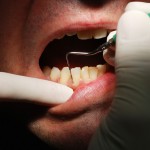
Professional mechanical plaque removal (PMPR) is routinely planned for patients with active periodontal disease to manage periodontal re-infection. It is usually combined with other relevant activities e.g. reinforcement and motivation of oral hygiene measures, and termed supportive periodontal therapy (SPT). The aim of this review was to evaluate the efficacy of long-term, routine, professional mechanical plaque removal (PMPR) in the prevention of periodontitis progression.
Methods
The Medline, Scopus, and the Cochrane Oral Health Group Specialty Trials’ Register databases were searched for English language studies. Handsearching was also conducted in the Journal of Clinical Periodontology, Journal of Periodontology, Journal of Periodontal Research, the clinical supplement of the Journal of Dental Research and the proceedings of the European Workshops on Periodontology. Randomised controlled trials, quasi-randomized clinical trials and non-randomized studies (i.e. controlled clinical trials, cohort studies and case series were considered.
Two reviewers carried out study selection independently. The primary outcome was tooth loss. A wide range of secondary outcomes were considered eg. clinical attachment level (CAL); probing depth (PD); bleeding on probing (BoP) ; patient reported outcomes. Methodological quality was assessed using a specifically developed scale providing a score (max = 9). Because of substantial heterogeneity a narrative summary was presented.
Results
- 19 studies were included with sample sizes ranging from 11- 225 patients
- Follow up periods varied from 3-14 years.
- No randomised controlled trials were included.
- In most studies PMPR was combined with patient motivation to oral hygiene and/or oral hygiene instruction. – None involved antibiotics.
- 12 studies reported on tooth loss; 10 on clinical attachment level; 14 on pocket depth; 10 bleeding on probing; 12 plaque and calculus levels; 3 gingival recession; 4 alveolar bone changes.
- No studies were included on furcation lesions; tooth mobility or patient reported outcomes.
Conclusions
The authors concluded:
…patients treated for periodontitis can maintain their dentition with limited variations in periodontal parameters when regularly complying with a SPT regimen based on routine PMPR. On the basis of the existing evidence, however, the true magnitude of the impact of PMPR on long-term tooth survival and stability of periodontal parameters has still to be assessed.
Comments
While this review has searched a good range of databases the restriction to English language studies means that it is possible that relevant studies have been missed. The authors have used a specifically designed tool to assess the quality of the included studies, which has a maximum score of 9. The Cochrane Collaboration does not favour this type of approach as it assumes each scoring element has the same weight when some aspects of study design have a greater impact on potential biases. Overall while this review finds PMPR beneficial, more evidence is needed regarding the size of the impact and patient reported outcomes.
Links
Trombelli L, Franceschetti G, Farina R. Effect of professional mechanical plaque removal performed on a long-term, routine basis in the secondary prevention of periodontitis: a systematic review. J Clin Periodontol. 2015 Apr;42 Suppl 16:S221-36. doi: 10.1111/jcpe.12339. PubMed PMID: 25495875.

Dear Derek,
Thank you for sharing the contents of your blog dedicated to our systematic review. I took a look at the material. With regard to the section dedicated to the results, I noticed that a detailed description is given on the results of the literature search, but no information has been included regarding the primary and secondary outcome variables (i.e., low tooth loss and yearly rate of tooth loss during SPT, low change in clinical attachment level and probing depths, etc). I think that these data are essential and should be incorporated.
Best regards,
Roberto Farina